Mazesoba (Japanese : まぜそば) may refer to:
- Aburasoba, Japanese noodle dish category
- Taiwan mazesoba, a noodle dish from Nagoya, Japan
Mazesoba (Japanese : まぜそば) may refer to:

Okonomiyaki is a Japanese savory pancake containing a variety of ingredients in a wheat-flour-based batter; it is an example of konamono. The name is derived from the word okonomi, meaning "how you like" or "what you like", and yaki meaning "cooked". Okonomiyaki is mainly associated with the Kansai or Hiroshima areas of Japan, but is widely available throughout the country. Toppings and batters tend to vary according to region. In Tokyo, there is a semi-liquid okonomiyaki called monjayaki.
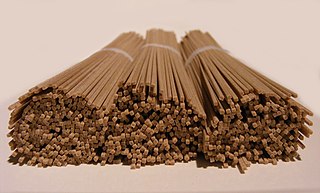
Soba is a thin Japanese noodle made from buckwheat. The noodles are served either chilled with a dipping sauce, or hot in a noodle soup. The variety Nagano soba includes wheat flour.

Chow mein are Chinese stir-fried noodles with vegetables and sometimes meat or tofu; the name is a romanization of the Taishanese chāu-mèn. The dish is popular throughout the Chinese diaspora and appears on the menus of most Chinese restaurants abroad. It is particularly popular in India, Nepal, the UK, and the US.

Yakisoba, "fried noodle", is a Japanese noodle stir-fry dish. Usually soba means buckwheat, but soba in yakisoba means Chinese noodles made from wheat flour, and are typically flavored with a condiment similar to Worcestershire sauce. The dish first appeared in food stalls in Japan during the post World War II period.

Champon, also known as Chanpon, is a noodle dish that is a regional cuisine of Nagasaki, Japan. There are different versions in Japan, Korea and China. The dish was inspired by Chinese cuisine. Champon is made by frying pork, seafood and vegetables with lard; a soup made with chicken and pig bones is then added. Ramen noodles made especially for champon are added and then boiled. Unlike other ramen dishes, only one pan is needed as the noodles are boiled in the soup. Depending on the season and the situation, the ingredients differ. Hence the taste and style may depend on the location and time of year.
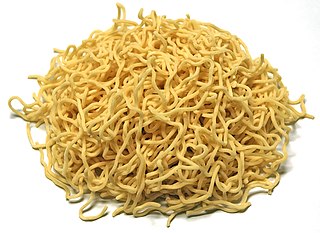
Noodles are a staple of Japanese cuisine. They are often served chilled with dipping sauces, or in soups or hot dishes.

Cellophane noodles, or fensi, sometimes called glass noodles, are a type of transparent noodle made from starch and water.

Fried noodles are common throughout East Asia, Southeast Asia and South Asia. Many varieties, cooking styles, and ingredients exist.

Korean Chinese cuisine is a hybrid cuisine developed by both ethnic Chinese and ethnic Koreans in China and South Korea. Despite being derived from Chinese cuisine, Korean Chinese cuisine consists of unique dishes with Korean flavors and ingredients. Most Korean Chinese restaurants outside South Korea are owned and operated by Koreans rather than ethnic Chinese, though Korean Chinese cuisine are sometimes available at Chinese restaurants. In both countries, the food is usually delivered.
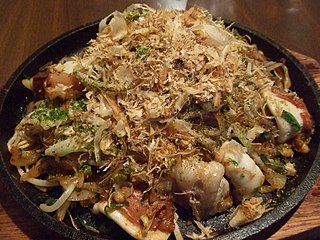
Yaki udon is a Japanese stir fry dish consisting of thick, smooth, white udon noodles mixed with a soy based sauce, meat, and vegetables. It is similar to yakisoba, which involves a similar stir fry technique using ramen-style wheat noodles. Yaki udon is relatively simple to make, and popular as a staple of Japan's izakaya, or pubs, eaten frequently as a late night snack. It originated in Kokura, Fukuoka Prefecture in southern Japan after the Pacific War. The widely accepted story of how the dish was created dates back to just after World War II, when food was scarce. The owner of the noodle restaurant Darumado used udon noodles in popular yakisoba preparations because the proper noodles were not available.

Korean noodles are noodles or noodle dishes in Korean cuisine, and are collectively referred to as "guksu" in native Korean or "myeon" in Sino-Korean vocabulary. Preparations with noodles are relatively simple and dates back to around BCE 6000 to BCE 5000 in Asia. In Korea, traditional noodle dishes are onmyeon, called guksu jangguk, naengmyeon, bibim guksu, kalguksu, kongguksu among others. In royal court, baekmyeon consisting of buckwheat noodles and pheasant broth, was regarded as the top quality noodle dish. Naengmyeon, with a cold soup mixed with dongchimi and beef brisk broth, was eaten in court during summer.
拉麵, 拉面, or 拉麺 may refer to:

Janchi-guksu or banquet noodles is a Korean noodle dish consisting of wheat flour noodles in a light broth made from anchovy and sometimes also dasima (kelp). Beef broth may be substituted for the anchovy broth. It is served with a sauce made from sesame oil, ganjang and small amounts of chili pepper powder and scallions. Thinly sliced jidan, gim (laver) and zucchini are added on top of the dish as garnishes. Janchi-guksu have various garnishes with noodles. The word "Janchi" means "feast" in Korean. The name came from where someone can taste it on a feast day such as marriage or one's sixtieth birthday.
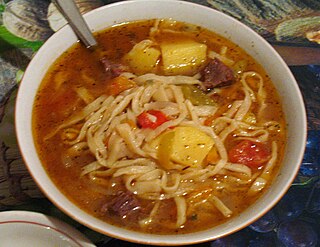
Kesme or erişte is a type of egg noodle found in various Turkic cuisines, including Kyrgyz and Kazakh cuisine. It is also found in Turkish cuisine and is called erişte and “kesme” in modern standard Turkish. The word itself is a nominalisation of the verb to cut or to slice, referring to the slicing of the dough involved in preparing the noodles. The term may refer to the noodles themselves, or the prepared dish made with them. Kesme is traditionally a homemade dish, and not often found at restaurants or cafés. In Turkey, kesme is also known as "erişte", and eaten generally in winter. It is made from flour, egg, water, salt and milk. These ingredients are worked into a dough, which is rolled out, cut, and dried in the sun or an oven after dried for a day.

Tonkotsu ramen (豚骨ラーメン) is a ramen dish that originated in Fukuoka, Fukuoka Prefecture on the Kyushu island of Japan, and it is a speciality dish in both Fukuoka and Kyushu. The soup broth is based on pork bones and other ingredients, which are typically boiled for several hours, and the dish is traditionally topped with sliced pork belly and served with ramen noodles that are hard in the center. In Fukuoka, Japan, tonkotsu ramen is referred to as Hakata ramen.
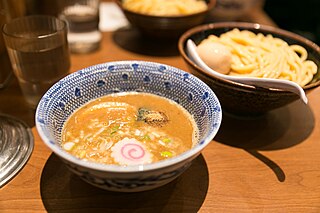
Tsukemen is a ramen dish in Japanese cuisine consisting of noodles which are eaten after being dipped in a separate bowl of soup or broth. The dish was invented in 1961 by Kazuo Yamagishi, a restaurateur in Tokyo, Japan, after which it has become a very popular dish in Tokyo and throughout Japan. In the United States, tsukemen has become popular in Los Angeles, while it remains relatively uncommon in other American cities.

Dandan noodles or dandanmian is a noodle dish originating from Chinese Sichuan cuisine. It consists of a spicy sauce usually containing preserved vegetables, chili oil, Sichuan pepper, minced pork, and scallions served over noodles. The dish can either be served dry or as a noodle soup.
Mazesoba, also known as abura soba (油そば), monjasoba (もんじゃそば), tenukisoba (手抜きそば), abu ramen (あぶラーメン) or shirunashi ramen (汁なしラーメン), is a dry noodle dish made with a sauce of soy sauce and pork lard. Traditional ingredients include shoyu tare base, aroma oil, menma, shredded nori, and green onions. Other variations also include toppings like raw garlic, raw egg, cheese, and minced meat, which are mixed with the noodles before eating.
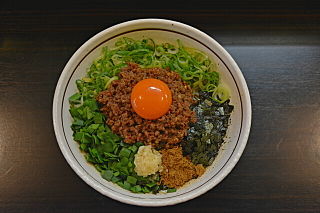
Taiwan mazesoba is a dry noodle dish that originated in Nagoya, Aichi Prefecture, and is now considered a Nagoya delicacy. The dish was invented by the ramen chain Menya Hanabi in 2008.